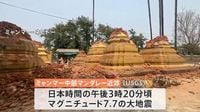A magnitude 7.7 earthquake struck central Myanmar on March 28, 2025, causing significant tremors felt across the region, including in the capital of neighboring Thailand, Bangkok. The U.S. Geological Survey (USGS) reported that the earthquake occurred at approximately 12:50 PM local time, about 33 kilometers west-southwest of Mandalay, Myanmar's second-largest city with a population of 1.2 million, and 248 kilometers northwest of the capital, Naypyidaw. The earthquake's epicenter was located at a depth of 10 kilometers, and it was followed by a magnitude 6.4 aftershock approximately ten minutes later.
Witnesses described the initial shaking as a horizontal sway that gradually intensified, leading to panic among residents in Bangkok. A Japanese resident in Thailand recounted, "At first, it was a side-to-side shaking that gradually grew stronger. Thai people were in a panic." Streets in Bangkok were quickly filled with citizens evacuating from buildings, with reports indicating that a high-rise construction site near the famous Chatuchak Market collapsed, leaving at least 90 workers missing.
As emergency services mobilized, images of the destruction began to circulate on social media, capturing the moment buildings crumbled and dust clouds enveloped the streets. The chaos extended beyond Myanmar, with tremors felt as far away as Hanoi in northern Vietnam and Ho Chi Minh City in the south. In Hanoi, hundreds of people evacuated high-rise buildings, while in Ho Chi Minh City, reports of cracks in walls began to emerge.
In Myanmar, the situation was dire. By the morning of March 28, local reports indicated that at least 20 people had died and over 300 were injured at Mandalay General Hospital alone. A medical staff member at the hospital stated, "The number of injured continues to increase, but there are not enough doctors and nurses to treat them, and medical supplies are almost gone." The hospital's emergency room was overwhelmed, with injured individuals lining up outside, waiting for care.
Local media reported that the earthquake caused the collapse of a monastery, resulting in the deaths of at least six people, including five children. Additionally, a hotel collapse claimed two lives and left 20 others trapped beneath the rubble. As rescue operations continued, the full extent of the destruction was still being assessed, with many areas experiencing significant structural damage. In Naypyidaw, highways buckled, and numerous buildings and bridges collapsed.
The Thai Prime Minister, Patompong Sinarat, declared a state of emergency in response to the widespread panic and damage caused by the earthquake. The Thai stock exchange halted all transactions, and some subway and light rail services were suspended as the city grappled with the aftermath of the quake.
In Yunnan Province, China, which borders Myanmar, authorities reported at least two injuries as a result of the tremors. Local officials activated their earthquake emergency response system and convened an emergency meeting to assess the situation. The USGS has estimated that there is a 77% chance that the death toll from the earthquake could exceed 1,000, indicating the potential for widespread disaster relief efforts to be necessary.
Economically, the earthquake's impact on Myanmar could be severe, with estimates suggesting that damages may reach 20-30% of the country's gross domestic product (GDP). Myanmar is no stranger to seismic activity; between 1930 and 1956, six significant earthquakes of magnitude 7.0 or higher were recorded. The current earthquake's devastation is exacerbated by the prevalence of informal and poorly constructed buildings in the affected areas, which are particularly vulnerable to seismic events.
As the situation develops, there are growing concerns about the potential for further aftershocks and additional structural collapses. The USGS has warned of the likelihood of landslides and soil liquefaction, which could complicate rescue efforts and increase the risk of further casualties. The international community is already beginning to mobilize support for the affected regions, with humanitarian organizations preparing to provide assistance to those in need.
The earthquake in Myanmar serves as a stark reminder of the region's vulnerability to natural disasters and the importance of preparedness and resilient infrastructure. As rescue operations continue and the full scale of the disaster becomes clearer, the focus will shift to recovery and rebuilding efforts in the coming weeks.







